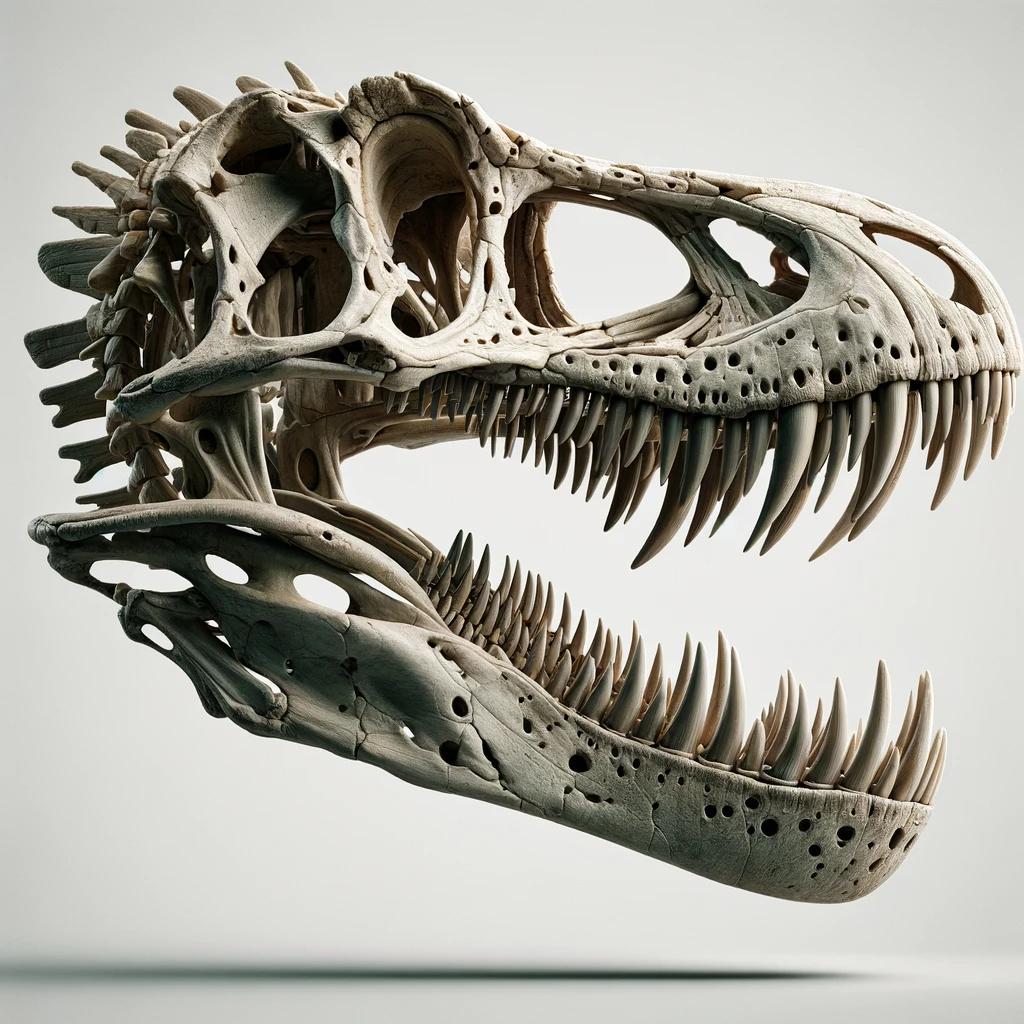What Dinosaur Has 500 Teeth ? | Mystery of the 500-Toothed Dinosaur
Dinosaurs, a diverse group of reptiles of the clade Dinosauria, have captivated the imagination of scientists and the public alike since their first fossil discovery in the early 19th century. They first appeared during the Mesozoic Era, around 230 million years ago, and were the dominant terrestrial vertebrates for over 160 million years, until their abrupt extinction approximately 66 million years ago.
The word "dinosaur" was coined by Sir Richard Owen in 1842, derived from the Greek words "deinos" (terrible) and "sauros" (lizard). This term reflects the awe that these creatures inspire, characterized by their extraordinary size, diverse forms, and complex behaviors. Dinosaurs are broadly divided into two groups based on their hip structure: the Saurischia, or "lizard-hipped" dinosaurs, and the Ornithischia, or "bird-hipped" dinosaurs. This classification has been fundamental in understanding their evolutionary history and relationship with modern birds.
Dinosaurs varied significantly in size and shape. Some, like the massive Sauropods such as Brachiosaurus and Diplodocus, were the largest animals ever to walk the Earth. Others, like the swift and agile Velociraptor, were smaller but no less formidable. Their diets were as diverse as their forms, ranging from the strictly herbivorous Triceratops to the carnivorous Tyrannosaurus rex, highlighting a complex ecosystem where these creatures thrived.
The study of dinosaurs has advanced significantly with modern technology. Paleontologists now use tools like CT scans and 3D modeling to study fossilized remains, giving insights into how these creatures lived, moved, and even what sounds they might have made. The discovery of fossilized feathers on some species has revolutionized our understanding of the connection between dinosaurs and birds, suggesting that some dinosaurs were feathered and that birds are modern-day descendants of a group of theropod dinosaurs.
The extinction of dinosaurs, likely caused by a combination of volcanic activity and a massive asteroid impact, marked the end of an era but also paved the way for mammals and, eventually, humans to become the dominant forms of life on Earth. Their legacy continues to be a source of scientific discovery and public fascination, symbolizing the dynamic and ever-changing nature of life on our planet.

Exploring the Dinosaur with 500 Teeth
Exploring the dinosaur with 500 teeth, known as Nigersaurus, offers a fascinating glimpse into the world of prehistoric creatures. This remarkable dinosaur, whose name translates to "Niger Lizard," was a herbivore that lived approximately 110 million years ago during the middle Cretaceous period. Discovered in the Republic of Niger, this sauropod is renowned for its unique and astonishing dental structure.
The most distinguishing feature of Nigersaurus is its extensive dental array. Possessing more than 500 teeth, it had one of the most complex dental systems known in the dinosaur kingdom. This extensive set of teeth was not for predatory purposes but rather adapted for its herbivorous diet. The teeth were arranged in rows along the front edge of its jaws, forming a wide, squared-off muzzle that was highly effective in stripping foliage.
Nigersaurus was relatively small for a sauropod, measuring about 30 feet in length and weighing around four tons. This size was modest compared to some of its gigantic relatives. Its neck, though long, was shorter than that of many other sauropods, suggesting a different feeding strategy, likely grazing close to the ground. This is supported by its downward-facing snout, a feature unique among sauropods, which likely allowed it to feed on low-lying plants.
The discovery of Nigersaurus has contributed significantly to our understanding of sauropod diversity and ecology. Its unique adaptations demonstrate the variety of life forms that existed in prehistoric ecosystems and how different species evolved to fill various ecological niches. The study of its skull and teeth, in particular, provides valuable insights into the feeding habits of sauropods.
In conclusion, Nigersaurus stands out in the dinosaur world due to its remarkable dental structure. Its adaptations for a specialized diet offer a compelling example of evolutionary innovation. The study of this extraordinary dinosaur not only enriches our knowledge of the Cretaceous period but also underscores the diversity and complexity of prehistoric life.
Anatomy of the 500-Toothed Dinosaur

The 500-toothed dinosaur, Nigersaurus, presents a unique anatomy that has intrigued paleontologists for years. This dinosaur, which lived approximately 110 million years ago during the middle Cretaceous period, was discovered in the Republic of Niger. Nigersaurus was a sauropod, a group of large, long-necked herbivorous dinosaurs, but it stood out for its distinct features, especially its remarkable dental structure. Nigersaurus was relatively small for a sauropod, measuring about 30 feet in length. It had a short neck compared to other sauropods and a small, delicate skull. The most striking feature of Nigersaurus was its mouth, equipped with more than 500 teeth. This unusual dental arrangement has been the subject of extensive study and fascination. The teeth of Nigersaurus were arranged in rows along the jaws, forming a broad, straight-edged muzzle. This structure was ideally suited for its feeding habits. Nigersaurus was a ground-feeding dinosaur, grazing on low vegetation. Its mouth worked somewhat like a lawnmower, clipping off ferns and other plants close to the ground. The teeth were not only numerous but also continuously replaced. It's believed that Nigersaurus could replace each of its 500 teeth every 14 days, an incredibly rapid rate compared to other dinosaurs. This rapid tooth replacement was essential for Nigersaurus, given its diet of tough, fibrous plants. The teeth were small and peg-like, suited for stripping foliage rather than grinding or tearing. The wear patterns on the teeth suggest that Nigersaurus fed primarily on horsetails and ferns, which would have required less powerful jaw muscles than a diet of tougher vegetation. The skull of Nigersaurus was also notable for its large nostrils and elongated, window-like openings that reduced the weight of the head. This lightweight skull design was essential for supporting the extensive dental array without significantly increasing the weight of the head. In conclusion, the anatomy of Nigersaurus, particularly its 500-toothed jaw, offers a fascinating glimpse into the diversity of dinosaur adaptations. Its specialized teeth and feeding habits highlight the incredible range of ecological niches that dinosaurs occupied. Nigersaurus stands as a testament to the evolutionary ingenuity of these ancient creatures, adapting in remarkable ways to their environment.

The Habitat and Lifestyle
The habitat and lifestyle of Nigersaurus, the 500-toothed dinosaur, provide insight into the ecological dynamics of the mid-Cretaceous period, approximately 110 million years ago. This unique sauropod, discovered in the Republic of Niger, adapted to a specific ecological niche that influenced its lifestyle and behaviors.
Habitat: Nigersaurus lived in a lush, riverine environment that was part of a vast ecosystem known as the Elrhaz Formation, located in what is now the Sahara Desert. During the Cretaceous period, this area was a lush habitat with a tropical or subtropical climate. The region was characterized by its rich and diverse flora and fauna, including a variety of ferns, conifers, and flowering plants, as well as an abundance of water sources such as rivers and streams. This fertile environment provided ample food resources for herbivorous dinosaurs like Nigersaurus.
The presence of large water bodies also suggests that the area may have been prone to seasonal floods, creating a dynamic landscape that Nigersaurus and other creatures had to navigate. This environment was shared with other dinosaurs, including predatory theropods like Suchomimus and Carcharodontosaurus, as well as other sauropods and a variety of smaller herbivores and carnivores.
Lifestyle: Nigersaurus was a ground-feeding herbivore, with a lifestyle adapted to grazing on low-lying vegetation. Unlike the high-browsing sauropods that fed on tall trees, Nigersaurus's anatomy suggests it had a specialized feeding behavior. Its broad, straight-edged muzzle and more than 500 tiny teeth were perfectly suited for grazing on ferns, horsetails, and other ground plants. This unique feeding mechanism has been likened to a modern-day lawnmower, allowing Nigersaurus to efficiently consume large amounts of vegetation.
The social behavior of Nigersaurus is not well understood, but like many sauropods, it may have lived and moved in herds. Living in groups could have provided protection against predators, especially for younger, more vulnerable individuals. The herd lifestyle would also have been beneficial in navigating the diverse and potentially challenging terrain of their habitat.
In summary, the habitat and lifestyle of Nigersaurus were intricately linked. Its specialized anatomy was a direct response to the lush, ground-level vegetation of its riverine environment, demonstrating a unique adaptation among sauropods. The lush, dynamic ecosystem of the mid-Cretaceous Sahara provided a perfect backdrop for the life of this remarkable dinosaur.
Popular Myths Around the 500-Toothed Dinosaur
Dinosaurs have long captivated the imagination of both scientists and the public alike. Among the myriad of species that once roamed the earth, the 500-toothed dinosaur, commonly referred to as Nigersaurus, holds a unique place due to its peculiar dental structure and the myths surrounding it. This essay delves into these myths, exploring their origins and the truths they often obscure.
Myth 1: The Existence of 500 Teeth
Origin of the Myth : The name "500-toothed dinosaur" stems from the discovery of Nigersaurus, a herbivorous dinosaur known for its extensive dental array.
Reality : While Nigersaurus did have more teeth than most dinosaurs, the number 500 is an exaggeration. It had around 500 replacement teeth, but only about 50 active teeth at any given time. This adaptation was likely for efficiently processing plant material.
Myth 2: The Dinosaur's Diet
Common Belief : There's a widespread notion that due to its numerous teeth, this dinosaur was an aggressive carnivore.
The Truth : Contrary to this belief, Nigersaurus was a herbivore. Its teeth and jaw structure were optimized for grazing on low-lying plants, not for hunting or consuming meat.
Myth 3: Size and Strength
The Myth : Another popular myth is that the 500-toothed dinosaur was one of the largest and most formidable dinosaurs.
Reality Check : In fact, Nigersaurus was relatively small compared to other sauropods. It was about 30 feet long and had a delicate skull structure, indicating that it was not as robust as some of its larger cousins.
Myth 4: Extinction Causes
Popular Belief : A common misconception is that the 500-toothed dinosaur went extinct due to its specialized diet.
Scientific Understanding : Like many dinosaurs, the extinction of Nigersaurus is more likely attributed to broader environmental changes and possibly the impact of an asteroid, rather than its dietary specialization.
Conclusion
The myths surrounding the 500-toothed dinosaur are a testament to our fascination with these ancient creatures. However, they often overshadow the scientific truths. Nigersaurus, with its unique dental structure, was an exceptional herbivore adapted to its environment, rather than the mythical beast often portrayed in popular culture. Debunking these myths allows us to appreciate the true diversity and complexity of dinosaur life on Earth.
FAQ
-
What is the name of the dinosaur with 500 teeth?
- The dinosaur famous for having 500 teeth is called Nigersaurus.
-
Where was the Nigersaurus discovered?
- Nigersaurus was discovered in the Republic of Niger in Africa.
-
What period did Nigersaurus live in?
- Nigersaurus lived during the middle Cretaceous period, about 110 to 115 million years ago.
-
What did Nigersaurus eat?
- Nigersaurus was a herbivore, primarily feeding on plants. Its unique teeth structure suggests it grazed close to the ground.
-
How large was Nigersaurus?
- Nigersaurus was relatively small for a sauropod, measuring about 30 feet in length and weighing around 4 tons.
-
What was unique about Nigersaurus's teeth?
- Nigersaurus had more than 500 teeth, which were arranged in rows that were continuously replaced. Its mouth was wide, and the teeth were suited for grazing vegetation.
-
How was Nigersaurus different from other sauropods?
- Unlike other sauropods, Nigersaurus had a shorter neck and a wide, shovel-shaped mouth, adaptations that were likely beneficial for low-level browsing.
-
Are there any complete fossils of Nigersaurus?
- A nearly complete skull and partial skeleton have been found, offering significant insights into its physical structure and feeding habits.
